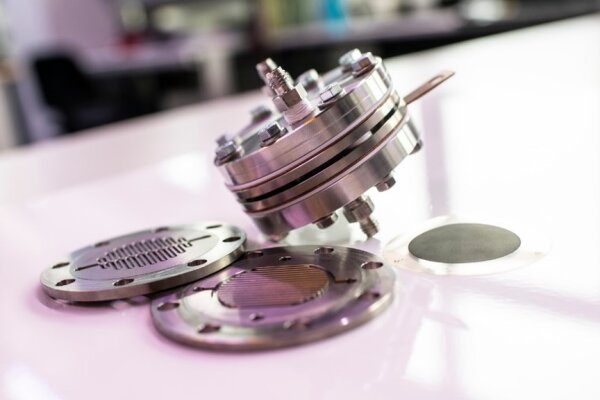15.05.2023

A current research project of the Chairs of Urban Water Management and Environmental Engineering (Faculty of Civil and Environmental Engineering) and Inorganic Chemistry (Faculty of Chemistry) together with Fraunhofer Umsicht aims to develop an electrochemical-microbial system for the implementation of a decentralised power-to-gas concept in municipal wastewater treatment plants.
A steadily growing number of industrial pilot plants are in operation worldwide, coupling a methanation stage with electrolysers and moving from a power-to-hydrogen to a power-to-methane concept as green energy storage. In this process, surplus electricity from renewable energy sources is converted into high-grade methane (CH4), which can be easily stored and distributed via the existing natural gas infrastructure. In this process, the biological fixation of carbon dioxide (CO2) with hydrogen (H2) to CH4 can be carried out by methanogenic archaea with high product selectivity and high conversion rates. Moreover, these biological catalysts are very resistant to impurities from the feed gases, which is a very important advantage over the thermochemical methanation process. In this context, the Chairs of Urban Water Management and Environmental Engineering and Bioinorganic Chemistry at Ruhr-Universität Bochum are conducting research together with Fraunhofer Umsicht on the development of an electrochemical-microbial system for the implementation of power-to-CH4 plants at wastewater treatment plants.
There are several reasons for the focus on wastewater treatment plants. First of all, the availability of nutrient-rich liquid streams and waste gases with high CO2 content (e.g. biogas or waste gases from sewage sludge incineration), combined with good infrastructure close to densely populated areas. In addition, sewage treatment plants are already existing complex infrastructures operated by qualified personnel - factors that can significantly accelerate the introduction of the technology. In this way, decentralised production and use of green CH4 is possible, in a circular economy, as no additional nutrients or substrates need to be purchased.
A current research project of the Chairs of Urban Water Management and Environmental Engineering (Faculty of Civil and Environmental Engineering) and Inorganic Chemistry (Faculty of Chemistry) together with Fraunhofer Umsicht aims to develop an electrochemical-microbial system for the implementation of a decentralised power-to-gas concept in municipal wastewater treatment plants.
A steadily growing number of industrial pilot plants are in operation worldwide, coupling a methanation stage with electrolysers and moving from a power-to-hydrogen to a power-to-methane concept as green energy storage. In this process, surplus electricity from renewable energy sources is converted into high-grade methane (CH4), which can be easily stored and distributed via the existing natural gas infrastructure. In this process, the biological fixation of carbon dioxide (CO2) with hydrogen (H2) to CH4 can be carried out by methanogenic archaea with high product selectivity and high conversion rates. Moreover, these biological catalysts are very resistant to impurities from the feed gases, which is a very important advantage over the thermochemical methanation process. In this context, the Chairs of Urban Water Management and Environmental Engineering and Bioinorganic Chemistry at Ruhr-Universität Bochum are conducting research together with Fraunhofer Umsicht on the development of an electrochemical-microbial system for the implementation of power-to-CH4 plants at wastewater treatment plants.
There are several reasons for the focus on wastewater treatment plants. First of all, the availability of nutrient-rich liquid streams and waste gases with high CO2 content (e.g. biogas or waste gases from sewage sludge incineration), combined with good infrastructure close to densely populated areas. In addition, sewage treatment plants are already existing complex infrastructures operated by qualified personnel - factors that can significantly accelerate the introduction of the technology. In this way, decentralised production and use of green CH4 is possible, in a circular economy, as no additional nutrients or substrates need to be purchased.
The concept currently being developed at RUB focuses on integrating an electrolyser directly into the biological stage, thus avoiding additional plant components for H2 storage and injection. Using a newly developed electrochemical reactor with a robust pentlandite-type transition metal sulphide catalyst, it is now possible to ensure efficient H2 production directly in real wastewater streams. This selected catalyst is based on elements that are abundant in the earth rather than the much rarer precious metals. This in situ generated H2 enables selective CH4 production over long periods of time with hydrogenotrophic methanogens (such as Methanobacterium and Methanobrevibacter). The energy conversion efficiencies of over 40 % and current densities of up to 30 mA cm-2 achieved with this novel system are the closest to date to the practical requirements for bioelectrochemical methane production with globally outstanding conversion rates.
Understanding the electrochemical and microbiological conversion processes is crucial for the efficient operation of these coupled systems, which use complex wastewater matrices as nutrient sources. Therefore, the model-based analysis of the experimental results carried out in this project is of high importance.
With the help of these experimental and mathematical models, it is possible to estimate the performance of this system under different implementation scenarios and also to quantify further positive impacts of this power-to-gas technology on wastewater treatment plants. Firstly, the growth of methanogenic biomass leads to additional elimination of nutrients such as nitrogen and phosphorus, which reduces the load on biological basins. Secondly, the oxygen formed at the anode of the electrolyser can be fed into the aerated biological wastewater basins, reducing the need for aeration, the largest energy consumer at wastewater treatment plants.
Contact Persons
Dr.-Ing. Tito Gehring
Chair of Urban Water Management and Environmental Engineering
Ruhr-University Bochum
Universitaetsstrasse 150
D - 44780 Bochum / Germany
Phone: +49 (0)234 32 22736
E-mail: tito.gehring@rub.de
www.ruhr-uni-bochum.de/siwawi/
https://orcid.org/0000-0001-7260-9868
Prof. Dr. rer. nat. Ulf-Peter Apfel
Inorganic Chemistry 1
Ruhr-University Bochum
Universitaetsstrasse 150
D - 44780 Bochum / Germany
Room: NC 1/71a
Phone: +49 (0)234 3221831
Email: Ulf.Apfel@rub.de
Head of Department Electrosynthesis
Fraunhofer-Institut für Umwelt-, Sicherheits- und Energietechnik UMSICHT
Osterfelder Str. 3
46047 Oberhausen
Phone: +49 2088598 1571
www.umsicht.fraunhofer.de (Department Electrosynthesis)